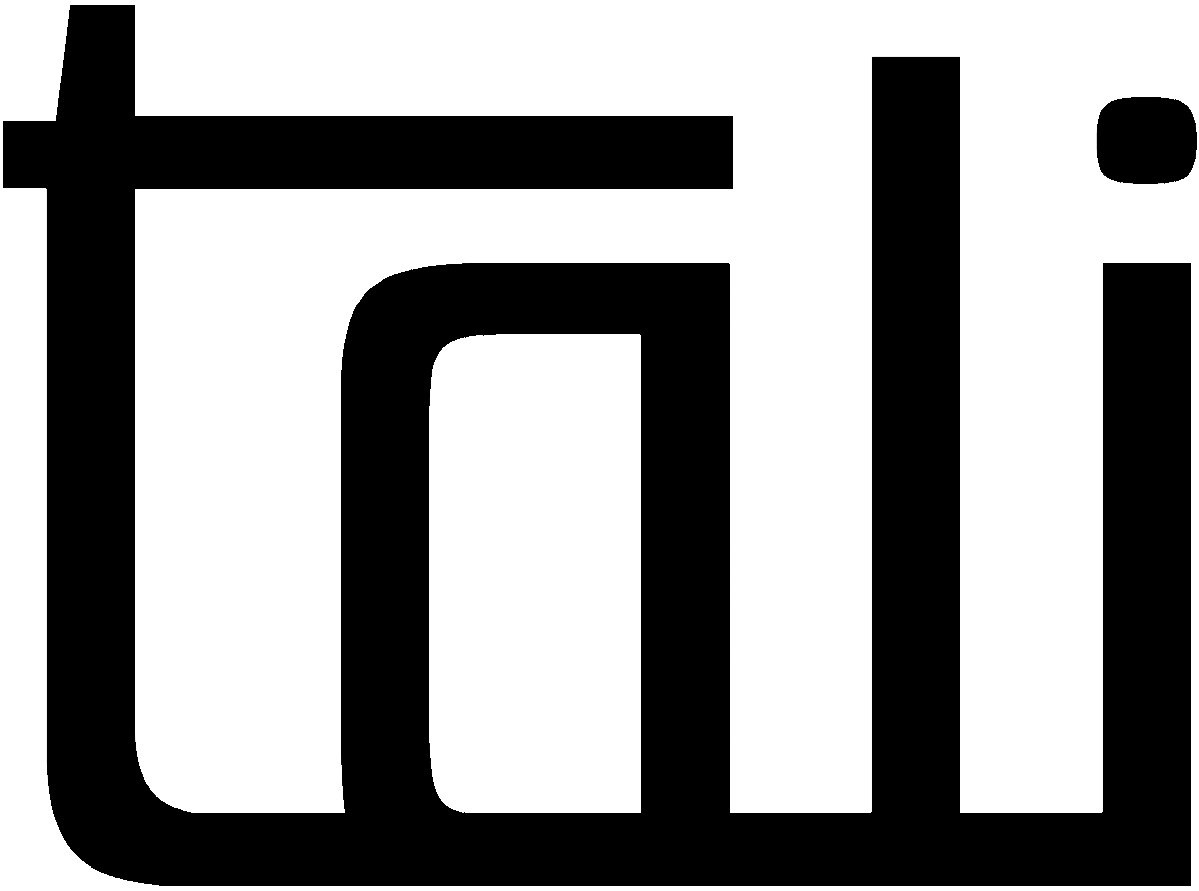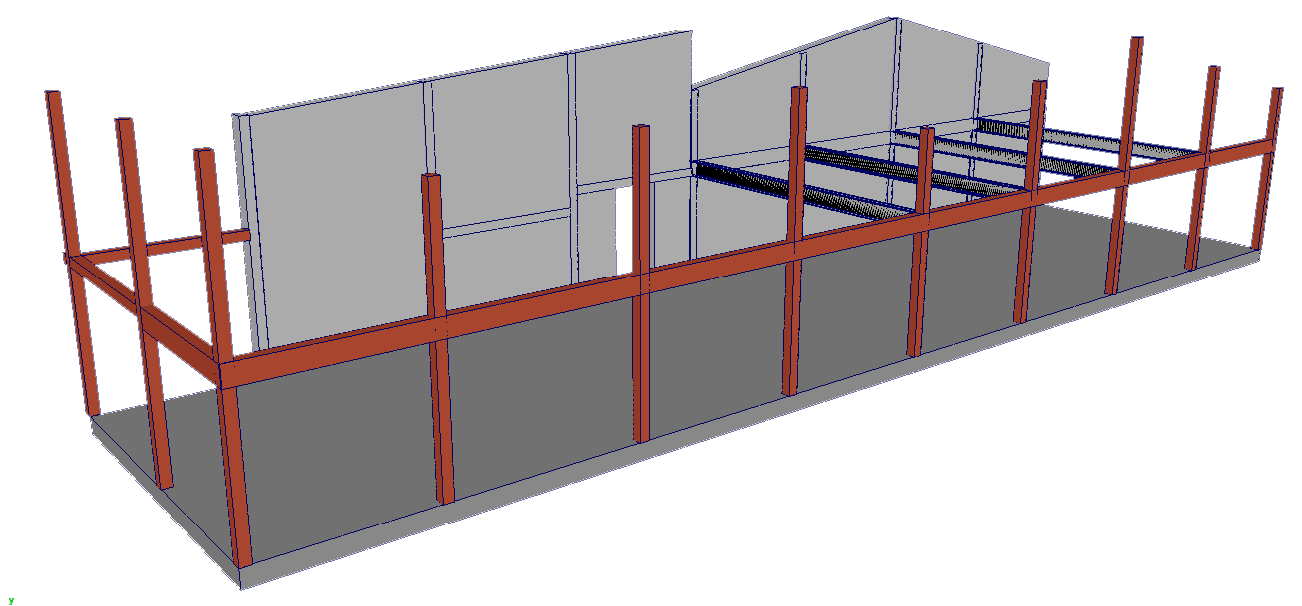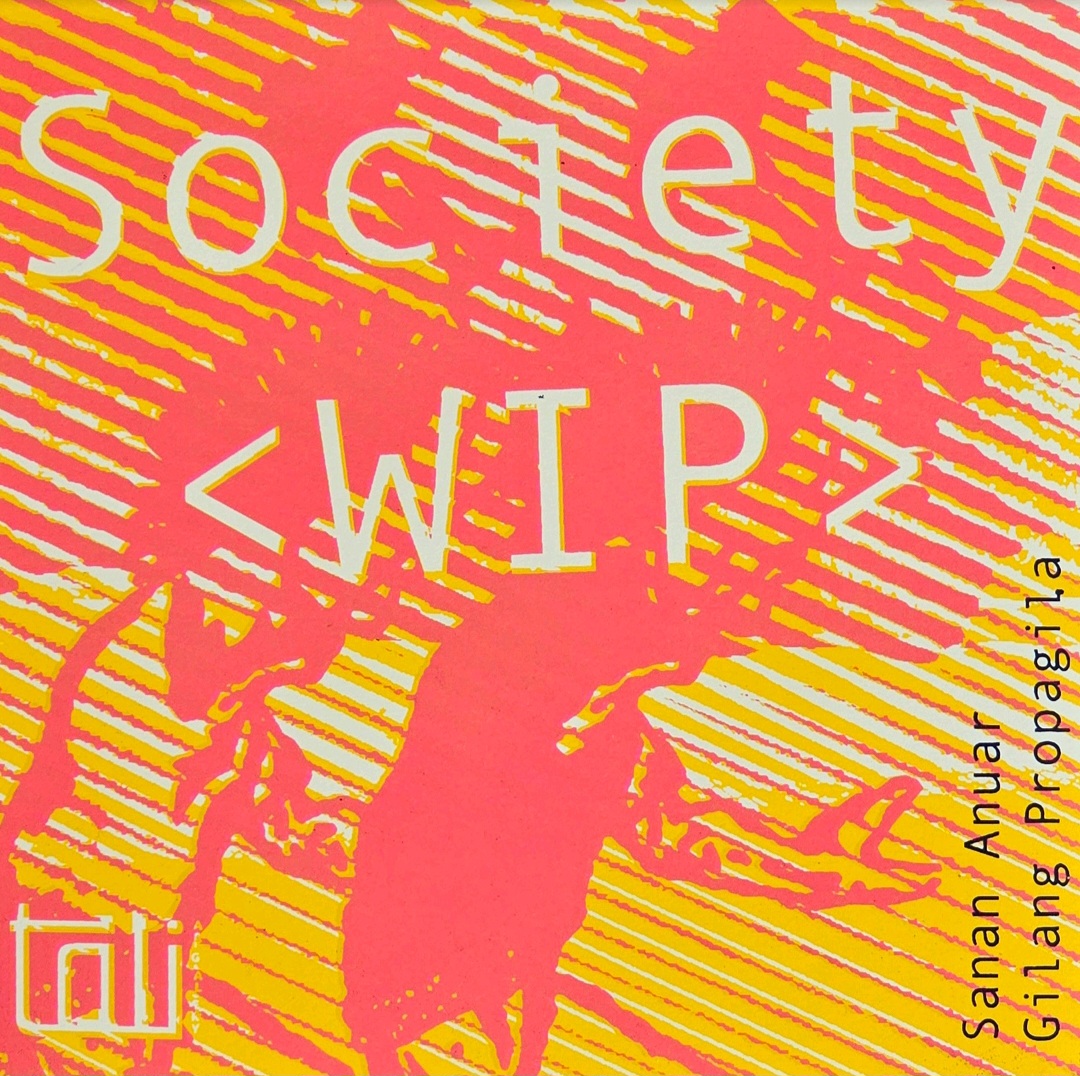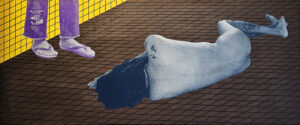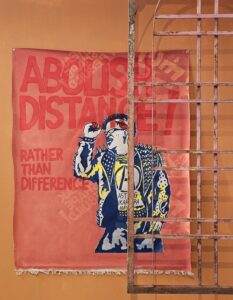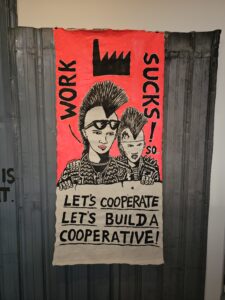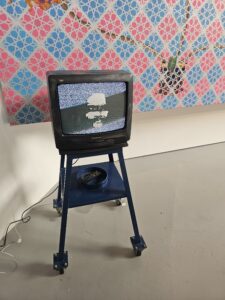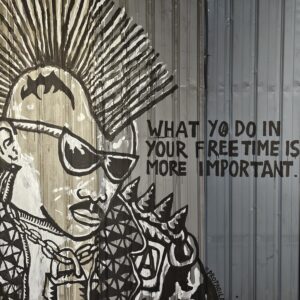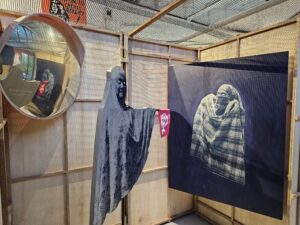Society WIP
06 – 31 August 2025
A duo exhibition by Sanan Anuar and Gilang Propagila
Featuring Balinese punk artist, illustrator, and zine maker/collector Gilang Propagila, and KL-based artist and printmaker Sanan Anuar, « Society Work In Progress » breaks the boundaries of the white cube to question society, its complex set of customs, codes, ideologies, hypocrisies, and simple beauty.
Excerpts from the catalogue
Art galleries project an essence that transforms whatever enters them. Their space is one of expectation, almost of a model, and their influence extends beyond simple presentation. This temporary assimilation offers new conditions for aesthetic and conceptual appreciation, which — replacing any direct function or reality — surround the artwork with an aura that becomes its new surface of contact with the world. The displaced object becomes alienated. A used spoon, chair, or car offers, within the gallery’s confines, a very similar experience, varying only through a thin, slightly anecdotal narrative thread. To recover its full charge, one must go beyond this constrained process of essentialization by fragmenting shared references.
Breaking away from the strict gallery paradigm challenges the limits of creativity as it confronts the limits of the acceptable, and more broadly, interrogates our own position to it. The extraction from the white cube reveals echoes of community-based constructions, with shared reference frameworks — a coherent space that embraces everything within it and passively or actively rejects the rest. Beyond the reassuring yet exclusive framework of community and resemblance, society offers a perspective on the world that is constantly shifting and decentred. Society WIP plays with these boundaries to question the social system within which we all evolve, to find richness of the fractures that sometimes split apart overly self-contained and serene entities.
In these conditions, pushing the opposite charges of resemblance and singularity, collaboration relies entirely on framed intention. The artworks overlap, at times clash, and then only can art truly emerge. Piece by piece, fragment by fragment, a large installation takes shape from simple elements: words, signs, colours, metal, objects, and recycled wood — all treated as materials of a vast reconstruction, forming a prototype of micro-society, enhanced with each new experience it generates — a work in progress whose energy stems from a beneficial instability.
Each object, idea, attitude, or behaviour is a complex blend of decision, use, heritage, and shared codes. Questioning the boundaries of the gallery does more than just facilitate the exchange of concepts and perspectives between its distinctive space and the elsewhere from which everything it houses originates. To break in order to remake — with the aim of rethinking the contexts that shape our experience — is not to propose a defined third space, nor any kind of solution. In this somewhat chaotic sensory spatiality — rich in both material and conceptual layers, a little messy, a little playful — the game of a decentred gaze is radically engaged. Art galleries carry no truth or validation.
Fragmenting these forms of reality to recombine them, shifting from political aesthetics to plastic aesthetics and return means transforming the exhibition into an experimental site of re-construction, where each idea, concept, object, and form of reality is rearranged to create a micro-proto-society of meaning and experience.
Society WIP is built on the dialectical foundation of two artists, aggregating two to provoke new agencies, only to be quickly dismantled in the visitor’s experience. It seeks to question society as an active curatorial phenomenon. Social rights, identity, religion, customs, pop culture and memories are set into motion, through the sincere yet irreverent eye of the artists. With giant bags screen-printed with random market pictures and clever ironic messages, Sanan Anuar reflects history back on itself by diverting the popification of activism into consumable objects, serving a more open concern toward religious injunctions. In his mural installation Gilang Propagila pushes the limits of words and images by projecting them onto an artificial stage wall, questioning the authenticity of intention. Both place signs at the heart of an ambiguity the exhibition does not claim to resolve. There are no messages or truth behind this controlled chaos, but rather a furious desire to provoke discomfort and a broader reflection about free and active expression.
Sanan Anuar and Gilang Propagila combine images and words as materials pushed to exhaustion. In the age of fluid contents, objectual anchors act as sensitive grips. An image without its own surface becomes slippery—and meaning slips with it. By reusing patterns and strong visual elements in a reduced set of combinatorics, they explore the richness of new possible experience to liberate their full charge.
Art constantly negotiates with insidious constraints. Every image arises from the vast system of language. Words enclose. Through them, through basic signs, consciousness is outlined within a constrained model – limits of which define an insidious enslavement, the comfort of a community, a magnetic nod. By refining its own coherence, the solid whole reflects on its impermeable surface the essentialised face of the Other. To escape from this subliminal gravitational force, one must superimpose greater agencies to provoke consciousness in return—a movement from meta-semiotics to macro-creativity. Intention stems in the broad strokes of the in-between. Like all living systems, language bears cracks artists joyfully inhabit.
Society stands in contrast with the centralized force of such a communal paradigm, stemming a new social shaping: no longer a carving that formalizes or a mould that rationalizes, but a collage of potentially exogenous elements shaped by a conscious operator—an act in itself, to reclaim control. The manner matters as much as the verbalization of intent. Gilang Propagila’s artworks are first signs and colours combined into indivisible concrete visuals. Sanan solidifies his patterns to better sculpt his own fragment of reality. Transparent meanings are delusive.
Frames operate on many scales to shape our vision, and theories push their solid -isms walls. Culture withers from being contemplated from the outside, tradition is its corpse. Looking backward is looking elsewhere, beside – it is already stepping out with no possible return. Image can be a guilty solidifier. At most, perhaps, remains the possibility of some intersecting paths.
Gilang Propagila and Sanan Anuar share fragments of similar trajectories – artistic development outside of classical education, and emancipation through punk scenes. Yet they diverged into frictional parallels—a vibrant oscillation of false overlaps. One impacts consciousness through illustration, playing with the boundaries of the image as a carrier of meaning in the service of language, the other provokes language through stable works subjected to the viewer’s questioning. Both interrogate and objectify meaning as a mouldable element; both perform sensitive intelligence.
What meaningful purity lies in Sanan’s Kelantanese past? What illusion hides behind the rooted essentialism of origin? Viewers would equally get lost trying to relate Gilang to any punk authenticity. Whether the boxes are checked/checkable or not doesn’t matter, down with the nauseating purities. The call to a codified aesthetic is above all a phenomenological grasp—a formalization, in the strictest sense, of an approach whose boundaries lie far beyond a strict referential framework.
To pin down Gilang Propagila or Sanan Anuar within the alternative scene or punk, and define it as such, is to invoke ghosts of once interconnected destinies. Historical punk is a colonial heritage, born in a specific place and time, half a century ago. To call on a heritage is to invoke a complex mechanism that contradicts the very reasons for its sincere adoption—values of assertion, fragmentation, voluntary recomposition, and DIY sociality. Let’s distinguish proud acknowledgement from labelling. Sanan Anuar does not wrestle with his past—he constructs. Gilang Propagila does not repeat a model—he uses it. And art arises through assemblage.
Society WIP rejects the idea of completion which brings closure, certainty, and antagonism. Its unstable rebounds engage us in an active journey, beyond the clashing intentions of its creators and the comfort of a defined and safe space. Objects and textures act, here, as meaning tracers to anchor a certain vulnerability in the viewer. Addition and disjunction highlight the different layers of experience from interaction with materials -including concepts- to symbolic or cultural consciousness. Outframing painting into installation, installation into a stage where the viewer originates its own fraction of circular experience breaks the illusional cycle of image and empty repeated words to reconnect with matter – either its narrative, sensitive charge or self-referring nihilism- and build thoughts.
By twisting echoes of everyday environments, the artists create the conditions of re-positioning and re-acting. Always society emerges out of will. Society WIP, as a sample of human playground, beyond all gender, religion, culture or ethnicity is above all an act of shared love, almost a sign of faith, and a big fat joke.
Altogether.
And that only matters.
No more Blank generation
(Blank Generation, Richard Hell & the Voidoids, 1977)
Once born the images, the images, the images and the sounds, the messages, the content designed for the containing we—then the original malleability for experience becomes swelling. No more boredom, no more distance, already congestion and the mind drowning, no uncertain gap in the arrangement of frames of reference, the bricks are set and passively patched up. Alas, the calibrated ordering, recomposition cascading into the fatal dilution of the tangible, of ideas and facts. No more blank generation, and from there: no future.
No valid present exists unless it generates itself infinitely. Its own contemplation in paper-dreams is a spinning screen, a rattle’s fascination. Debord described the self-referential artificial society of the spectacle, the perversion of desire through the distorting mirror of a naïve fantasy of the better-self seen through oneself only. In the dynamics of reciprocal pettiness, the ego finds reassurance in a form of average validation. Checking boxes—every box—blacks out a sad notebook and terminates the will within an overcrowded self.
Let’s run up Escher’s staircase.
No more Salut à toi
(Salut à toi [Hi to you], Bérurier Noir, 1989)
How to define this you who is not me—by difference or by classification? Should we rank in gradients the overlaps of some essentialist Venn diagram? To praise difference is to make it a guilty cult, to deny it is to be blind to the ambivalence of self and non-self that underpins our phenomenology of existence. In a globalized world, friction is a surface signal, incompatibility a failure. This is extreme violence. The Other itself participates in a vast organism that digests and digests and digests. What’s left is taste, few smells, and in the end, the same substance. The information world categorizes the Other a priori based on dictated foundations—the products of an essentializing process that, by its very method, is a long digestive tract. The over-referenced lived experience becomes dissociative. It gradually sediments, hardens, and takes shape. And tradition becomes coprophagic.
There will always be one word missing to describe, one second missing to meet, one love missing to embrace the world. And the ska checkerboard is nothing more than an old dialectical cliché.
No more Antisocial
(Antisocial, Trust, 1980)
Abolish distance rather than difference. Forget community, the core, the comfort of the similar; destroy the shelters, dare to face a tangible form of reality. Let go of you, I, him, embrace the 1, 2, 10. To smooth out contrasting saliences in the name of the whole is a subtle degree of alienation. No! to inclusivity that, by contrast, maintains the “normal” whole. The small small man would do well to see himself as such, abandon his reassuring attempts to understand any kind of totality, and finally aggregate the multiple forms of reality. To sum up joined entities, to build society, to assume and construct. Abandon the frame of references for the momentum, act out of will rather than learning. Let go of those for whom tomorrow was more beautiful yesterday.
To those who imagine the future only in their own image, who can build it only in their own likeness: take out your meat, and start working hard; to you the intoxication of DNA, of race and tradition. To engender is not to create. We will build on the rock of your failures.
There is a great sadness and an infinite arrogance in rebellion. The no past of the Futurists led straight to war, the no future of punk to a depressive pop phenomenon—and the present is burdened with interference.
Too much,
too much,
too much, then sit and talk.
Let’s finally build a few moments of pleasure, clinging to our memory, intense and lucid in the moment, and strong of a great desire, to resolve time into one vast body.
- Hanuman, Buddhas and the Priest, 2025
- Bermohon Sembah, 2024
- Abolish Distance, 2025
- Work Sucks, 2025
- Echo TV, 2025
- What you do in your free time, 2025
- Don’t Look Back in Anger, 2025
